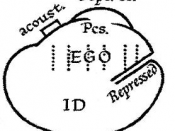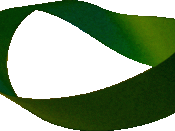The Moebius Strip is just one of the many figures Lacan used to describe his topological thinking. Lacan believed that Freud had fallen into the 'trap' of not dismissing any notion of physical relativity by dividing the human psyche into the id, the ego and the super-ego, thereby giving the impression to the casual viewer that there were essentially three distinct entities. Topology, though describing a space, does not deal with area, size or any other typical physical measurement. Rather it deals with subjects that are related together i.e. in one neighbourhood. Lacan believed that there should be a way of describing the structures of the psyche which does not lead to a rigid structure which supersedes the elements themselves while at the same time describing the structure itself. Lacan argues that topology is not simply a metaphorical way of expressing the concept of structure; it is structure itself (Evans, 208).
Along with his many schemata, the Torus, Klein's Bottle, The Moebius Strip is one of the topological ways and shapes/structures which attempts to describe the workings of the psyche.
The Moebius Strip can be formed by taking a long rectangular piece of paper and joining it together, twisting one side around as you stitch them together. This leaves you with one long continual piece of paper, with only one surface instead of two separate ones. The result is a figure that subverts the dimensional thinking we find in Freud (not to say Feud believed it to be so) of the three-fold structure of the id, the ego and the super-ego. Rather we find an image that is only defined by the time it takes to travel it. This apparent contradiction of shape is a useful way for psychoanalysts to illustrate how its many apparent contradictions of the human psyche...


